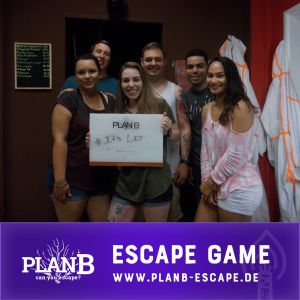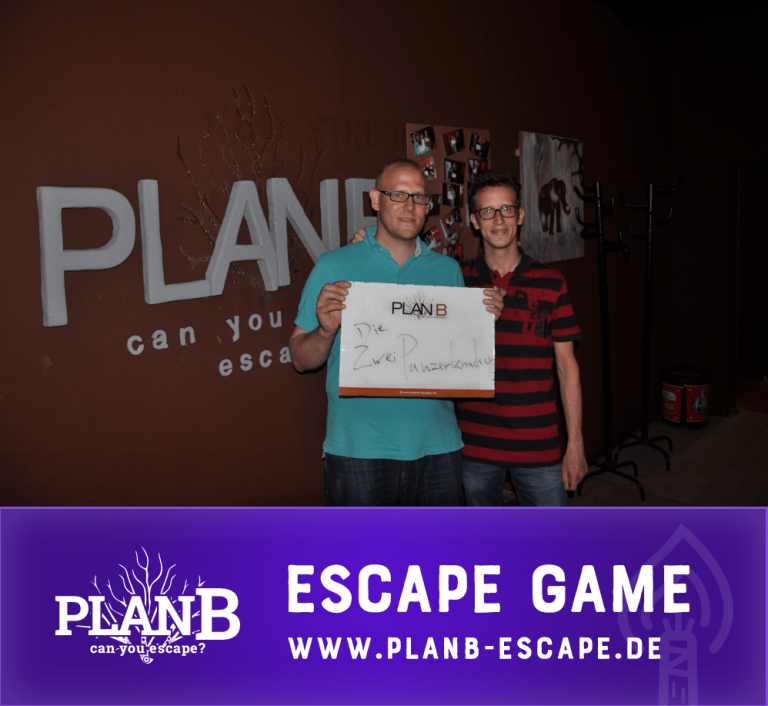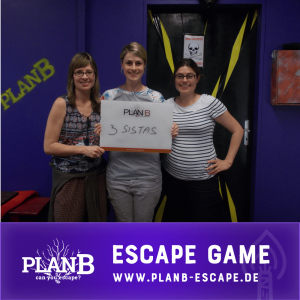The goal is to create an Escape Room that is the most fun, challenging, and that will captivate visitors to the Escape Game. Oh no, why limit yourself. The goal is to create the best Escape Game in the world! To do that, you need great puzzles.
You need tricky puzzles that challenge your customers but are also fun. The right balance of difficulty and time to get visitors to solve the puzzles without getting angry or frustrated. Our list of 100 exciting ideas for your Escape Room can be found in this blog post.
Remember, however, that if you copy them one to one, the ideas will lose their originality and the visitor will not experience a unique adventure. If everyone used the same puzzle ideas in their Escape Rooms, customers would get bored very quickly. So take these ideas and give them a touch of their own. All lovers of Escape Games and Exit Rooms will appreciate this.
Let’s get started!
Hidden messages and ciphers
Ciphers and other techniques to hide secret messages are a great way to give players information while ensuring that they can celebrate little successes in the Escape Room.
- Idea 1: Use Skytale encryption to hide a message.
- Idea 2: Hide a message using Snote
- Idea 3: Hide a message with a red revelation technique.
- Idea 4: Use a mask technique to reveal a hidden message.
- Idea 5: Similar to Idea 4 – use a postcard decoder to hide a message.
- Idea 6 – Use the NATO phonetic alphabet to create a message.
- Idea 7: If it fits the theme, write a coded message in a fictitious alphabet.
Play hide and seek
Finding something hidden is a particularly satisfying moment for Escape Game players. Although they still have to figure out what to do with the object they found, the moment of discovery always evokes a positive group dynamic in the Escape Room.
- Idea 8: Hide a clue in a fortune cookie.
- Idea 9: Hide elaborate Easter eggs or other objects that open easily in the Exit Room. Hide paper snippets with news fragments in them. Players must find them all to complete the message.
- Idea 10: Write a message on the back of a painting.
- Idea 11: Hide a message within a picture or painting.
- Idea 12: Design a drawer or trunk with a secret compartment and hide something in it.
- Idea 13: Hide a message at the bottom of an umbrella.
- Idea 14: Hide an object in the “stomach” of a skeleton as if it had been swallowed once. Players must unbutton the shirt of the skeleton and reach between the bones to get to the object.
- Idea 15: Place a board full of notes or equations in the room. Players must wipe away the chalk or erase the ink from the board to reveal a message written in permanent ink.
- Idea 16: Put an old research diary in the Escape Room. Hide cryptic clues in the notes.
- Idea 17: Leave an empty notepad on a desk. Players must scribble lightly with a pencil on top of a notepad to reveal the note written on the page above.
- Idea 18: Place a computer or tablet in the room that takes players to a room-specific website. Text and images on the website serve as clues.
- Idea 19: Write a message on something tiny and demand that players use a microscope to read it.
- Idea 20: Place a valuable clue somewhere in the room and remove the bottom section so that the instructions are incomplete. Hide the bottom section as a charred piece of paper that falls out of the chimney when players open the hood in the fireplace (as if someone tried to burn the paper).
Lock things up
Many live escape games use locks as support and puzzles. Be careful not to rely too much on this type of puzzle, or your customers will get bored. A few locks here and there, however, can provide satisfying moments of success that don’t take too much effort to be found out.
Combination locks
Here are some options for lock combinations.
- Idea 21: Use a book row (the kind that has numbers on the spine) and draw a diagonal line across the bottom of the books. Players must string the books together so that the line is straight, and then use the numbers on the spine as a combination.
- Idea 22: Write a combination in invisible ink on the bottom of a box with a lock.
- Idea 23: Write a combination on the inside of a lampshade.
- Idea 24: Write the combination using a Chinese take-out menu in which certain meals and the corresponding number are orbited.
- Idea 25: Provide already solved number puzzles with wrong answers. Demand that players in the Live Escape Room recognize which answers are wrong and that they use these numbers as a combination.
Key Locks
There are usually two steps to solving a key lock. First, the players have to find out which keys are part of the code. Then they must find out the order in which these keys are to be pressed.
You can place a notebook with a significant year or other clues elsewhere in the room to give them the correct order.
- Idea 26: When players blow powder on the combination lock in the Escape Room, the powder sticks to the buttons that have the most oil on them.
- Idea 27: A key combination with some of the buttons that are worn out shows players which keys have been used the most.
Find, close and open doors
Many escape rooms consist of several interconnected rooms and give the designers of a live escape game the opportunity to challenge the players with secret or locked doors.
Secret Doors
- Idea 28: Create a hidden door that can only be seen by the light that can seep in through cracks in the next room. So players can’t find the door if they don’t turn off the lights in the exit room.
- Idea 29: Create a hidden door that can be found when players feel a draught at the edges. A lighter may be enough to see where the flame flickers.
- Idea 30: Create a hidden bookcase door that requires you to pull the right book or a nearby wall lamp to open it.
- Idea 31: Make the back wall of a cupboard into a door that opens when another task in the room is completed; players must return to the cupboard to see that it is now open.
- Idea 32: Hide a secret door in the back fireplace. Players must crawl through the fireplace to get through the door.
Locked doors
- Idea 33: Hide a key in the drain. Players must use a magnet attached to a piece of wire to pick out the key.
- Idea 34: To make Idea 33 more challenging, players must remove the wire of a painting to which it is attached.
- Idea 35: If there is a prison cell or an escape room with bars, players can escape by opening the locked door with a mirror.
- Idea 36: Create a door without a visible lock that only opens when players use the correct knocking pattern.
- Idea 37: Program a desk drawer to remain locked until players knock at the right place on the table surface.
- Idea 38: Create a door that pops up when a certain action is performed elsewhere in the room but locks if players don’t access it immediately. One player must perform the task that opens the door, and another must pass through it or find a way to keep it open.
- Idea 39: Create an escape room with different types of tiles on the floor and a locked door on the other side. If players simply walk across the room, nothing happens. Players must come from one side of the escape room to the other without stepping on certain tiles or just stepping on the correct order of tiles to unlock the door.
- Idea 40: Give players a locked door with a key in the keyhole – but on the other side. To get the key and unlock the door, players have to push something flat, like a piece of paper or a mat, under the door at the height of the doorknob. Then they have to put something in their side of the keyhole to push out the key so that it lands on the flat object. They can then get the key by carefully pulling the flat object back to their side of the door. Note: With a puzzle like this, you must have prepared a backup solution if players push the key out without having prepared anything to catch it. Unlike a video game where players can see that they have missed a step and can return, the Live Escape game is too late once the key is on the floor in the next room.
Activities
Not all challenges should involve deciphering or unlocking things. Sometimes an exciting escape game requires unusual tasks or activities that require several steps to achieve an objective goal.
- Idea 41: Players must repair an electronic device by correctly configuring DIP switches.
- Idea 42: Players in an art gallery must imitate the poses of the statues.
- Idea 43: Similar to Idea 42, players must imitate a position (move their arms, legs, and heads) to imitate images available to them.
- Idea 44: Players must change an object of approximately the same weight.
- Idea 45: Players must figure out how to turn on an old radio (they may have to “repair” it first) and then set it to the correct frequency to hear acoustic cues.
- Idea 46: Players must make a musical instrument from the objects found in the Escape Room and use it to play a particular melody.
- Idea 47: Players must use a litmus test to analyze a solution. Note: Some players may not know what a litmus test is. Make sure there is an explanation and instructions somewhere in the room.
- Idea 48: Players must get behind the top drawer of a desk or filing cabinet to find items in a locked drawer underneath.
- Idea 49: Players must draw up a grandfather clock.
- Idea 50: Just from LOST: Give the players a computer keyboard and require them to enter a series of numbers at regular intervals to avoid a catastrophe.
- Idea 51: Players have to program a robot to perform a task they can’t do themselves.
- Idea 52: In Live Escape Game, provide an 8mm or 16mm film projector and a roll of film; players must use the projector to see the film. Note: Many players cannot know how to thread the movie through a projector. Make sure the instructions are available somewhere in the escape room.
- Idea 53: To make Idea 52 more challenging, give players the role of the movie in which a critical section is missing. Hide the section somewhere else and ask the players to insert the missing piece into the film to see the whole thing.
- Idea 54: A player in one room must perform a task by observing the instructions of a second player in another room on a monitor.
- Idea 55: Provide the players in the Live Escape Room with a flashlight that has no batteries. Elsewhere in the exit room, there is a clock or other object that uses the same type of batteries. Players must realize that they must remove the batteries from one object and use them in the other.
- Idea 56: Use a cryptic code to provide the correct on-off configuration for the light switch in a breaker box.
- Idea 57: Place a dispenser (such as cigarettes, drinks, or snack machine) in the room from which the players need something (such as a bottle of water to use in another puzzle). Players must find a coin or other object to access the object in the machine. Alternatively, players must find another way to access the object. [Note: Make sure the machine is screwed to the ground to prevent players from getting damaged].
- Idea 58: Give players a brief glimpse of a scattered set of objects or an image of multiple objects. Players must remember as many of the items as possible in order to use them later in the game. Note: Make sure that there is an indication that players know that their memories will be tested later or that they will be given a second chance to see the items.
- Idea 59: Send players into the future with a time travel device and ask them to figure out how to set it to return to the current time.
- Idea 60: Send players into the future with the time-travel machine and demand that they figure out how to repair them with tools that haven’t been invented yet.
Set decoration or puzzle
If you do a good job of creating an immersive environment, your escape room will contain some furniture and props that are only available for aesthetic purposes. Finding out what’s useful and what’s only part of the set decoration is part of the fun in Escape Game.
Mirrors and Paintings
- Idea 61: A mirror that becomes a painting showing a hint when players read an incantation or repeat “Bloody Mary” in front of it.
- Idea 62: A mirror in which players can see “spirits” or move around behind them in space. The activities of the ghosts can provide clues as to where things are hidden or how to operate machines.
- Idea 63: A painting in which the figures move when the players are not looking. The figures can point with the finger or rotate their heads to provide clues. Note: In a historical room where you don’t want to use a computer monitor or walkie-talkies as a clue system, this could be your solution.
- Idea 64: A painting in which the figures come closer to the frame when the players come closer to the correct answer and move further away when the players move away from the correct solution.
- Idea 65: A painting or old photo showing players in the Escape Room with a different furniture configuration. When the players rearrange the furniture, they activate a switch.
- Idea 66: To make the idea 65 more challenging, they leave one of the pieces of furniture broken or missing, which requires players to find a replacement for that place.
- Idea 67: A mirror through which the players can step into the “opposite world”. Players must use the teamwork between the two Escape Rooms to complete a task.
- Idea 68: When players straighten a crooked painting, they activate a switch with it.
- Idea 69: In the Live Escape Game, ask players to move an image sideways to find something behind it.
Flooring
- Idea 70: Make a hint about a part of the design on the floor or carpet, so it can only be read when players climb a ladder or find another high vantage point.
- Idea 71: Create an escape game puzzle in which players can only see the answer they’re looking for when they’re standing directly on a marked X.
- Idea 72: Create an escape room where the floor is a tile-slide puzzle. Players must first figure out how to move the tiles, then solve the puzzle.
- Idea 73: Create a room that is a version of a board game board transferred into reality. Players must act as figures on the board in an appropriate way to move to the next room section.
Environmental change
While a single room filled with puzzles can be fun, the possibilities that arise when players in the Escape Game move through a larger environment or make changes in the environment (whether real or fictitious) are significantly higher and the fun of discovery, as well as the sense of urgency, are significantly increased.
- Idea 74: Place players in a room that gets colder or warmer over time. Players need to figure out how to stabilize the temperature.
- Idea 75: Turn off the lights in the Escape Room and then turn them on again. Change something in the Escape Room every time the lights are off. Players need to see what’s changed.
- Idea 76: Players notify that they only have a limited amount of air. So they only have a certain amount of air available to make it to the other room (depending on the complexity of the puzzles in the first room – somewhere between 15 and 45 minutes).
- Idea 77: Provide the players with a lantern that almost runs out of oil or a flashlight with weak batteries. Players in the Live Escape game must make it to the next room before the lights go out.
- Idea 78: Lock each player in a separate room with their own set of puzzles. Once players escape from their separate rooms, they must all work together to escape in the central room. [Note: A game like this is suitable for repeated visits because each room has its own set of puzzles.]
- Idea 79: Place players in a room that gets smaller over time (for example, through walls that move slowly or a ceiling that lowers slowly). Players must figure out how to escape the Escape Room before they are “crushed”.
Interaction with the outside world
Escape spaces begin to blur the line between the game situation and interactive theatre. So many Escape Room providers create ways for players to interact with non-player characters or develop an awareness of the fictional world outside the Escape Room they are in.
- Idea 80: The first puzzle that players have to solve is how to get clues from the Game Master. The whole thing can be done through language, rhythm, or the like. In order to complete the tasks in the Escape Game, the players must interact successfully with the Game Master.
- Idea 81: Give players a walkie-talkie to communicate with a commander or extraction team. You need to find the right password to get a decisive answer.
- Idea 82: Use the sound of thunder outside the room to indicate the right time to perform a task. For example, players can perform a loud action where they don’t want the guards outside the room to hear them.
- Idea 83: Give an extremely quiet audible hint that can only be heard in complete silence. Players must stop talking and listen attentively.
- Idea 84: To make Idea 83 more challenging, fill the room with a loud sound, such as water rushing over a dam or a continuous beeping alarm. Players are expected to figure out how to turn off the sound (turn off the dam, turn off the alarm, etc.).
- Idea 85: Provide clues through short sound sequences that penetrate through the statics of a radio or television.
- Idea 86: Players in the Escape Room are expected to figure out how to access digital “captain’s protocols” or an “emergency signal” from a spaceship or space station.
- Idea 87: Let the players know that there is another prisoner in the next room. Let the prisoner send messages with a knock code. Note: Many players will not be familiar with this code. Make sure you have a key to decrypt the messages and give them enough time for all the important messages to solve the puzzle.
- Idea 88: To make Idea 87 more challenging, players must answer with the knock code.
- Idea 89: Insert a pet door and allow players to hear a cat or dog outside. When players push a bowl of cat or dog food through the pet door and wait, they will notice that the food is gone, and instead, there is a collar with a note in the bowl.
- Idea 90: Send a coded message to the players and demand a coded answer. Later in the Escape Game, their success in this task may affect their success with another puzzle (e.g., the later puzzle is much more difficult – but not impossible – if they have failed to send their message early in the course of the Escape Game).
- Idea 91: Paste important information into conversations conducted by actors (or a recording of actors) on the other side of a door or wall.
- Idea 92: Warn players of an imminent explosion or attack. When the moment comes, players must protect themselves by building a protective barrier to block fire or debris or find a safe hiding place.
- Idea 93: Create a task that requires players to use a lot of power. Use the sound of a thunderstorm “outside” to alert them to potential lightning strikes and require players in the Escape Room to access the energy of the lightning strikes via a lightning rod.
- Idea 94: Use the smell of cigarette smoke to alert players to an approaching guard or other non-player characters.
- Idea 95: Create “windows” that show players what’s going on outside the escape room or building; this information must be used to make progress or solve puzzles in the exit room. Note: Even if the things that players can see outside don’t help them solve puzzles, it can increase the immersive quality of the Escape Room. For example, awareness of the growing number of zombies outside the “window” can create a sense of urgency.]
Get the players out of their comfort zones
Depending on the escape room theme, players may be willing to get a little dirty or do things they wouldn’t normally do. Just make sure that for the appropriate Escape Room, a clue/warning informs customers that the Escape Game contains scary or unpleasant elements.
- Idea 96: Players must reach into a tub or sink of stinking water to get a key or clue.
- Idea 97: Players must use a bucket to get dirty water from a tub or sink and use it for another puzzle.
- Idea 98: Create a room that is only accessible by having several players climb into a large “drawer” and be pushed through the wall by the other players.
- Idea 99: Players must grab through cobwebs, beetles, or something slimy to get a key or clue.
- Idea 100: Give players an item they need to complete a task in another room, but make it impossible to carry the object through the door (for example, the door could lock every time they approach with the object in their hands). Players must find an alternative way to move the object into the other room. For example, crawling through a narrow vent or a dirty tunnel under the floor.
Go wild! Our list of 100 exciting puzzle ideas for the next Escape Room. We hope these ideas have brought your imagination to life and given you the spark you need to create an exciting and challenging exit game that will delight your customers.








